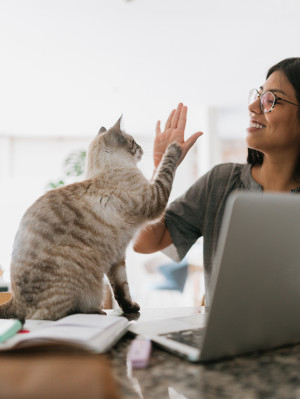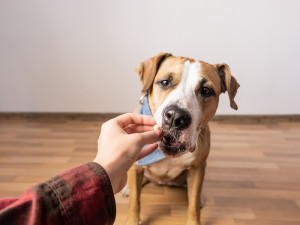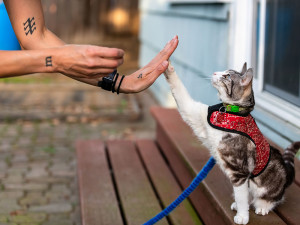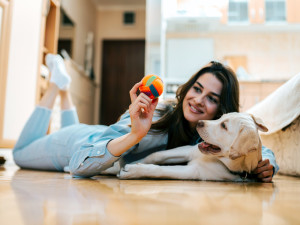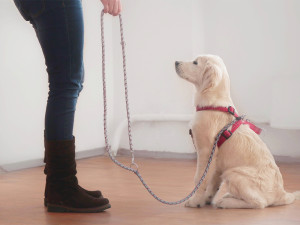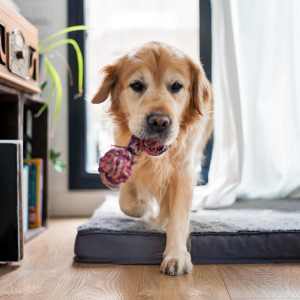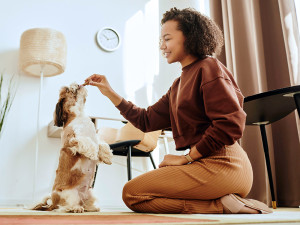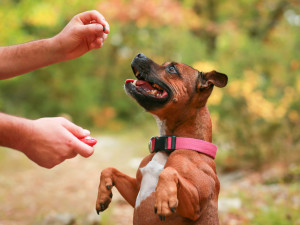Viral ‘Hands-In’ Challenge: How To Get Your Pet To Paw-Ticipate
An animal behaviourist explains why they do (and don’t) get involved in the game
Earlier this month, the ‘paws in’ challenge went viral on social media, with pet parents sitting with their dogs or cats and putting their hands in the centre to see if their furry companions get the hint and stack their paws on top. Also known as the ‘hands in’ or ‘all hands on deck’ challenge, videos of cute human and animal families participating have racked up millions of views.
The videos showcase heartwarming moments of mutual understanding and affection between animals and their pet parents – and they’re sometimes even cuter when the animals do something unexpectedopens in a new tab. Take Blue from Battersea, for instance, who just wants to get involved but can’t quite figure out where to place her paws.
littleKin™ is Kinship’s home just for puppy and kitten parents. Bop over to check out expert advice, new pet tools, and special deals—all curated for your newest family member.
opens in a new tabThe simplicity of the challenge also makes it accessible: it doesn’t require special equipment or extensive training, allowing almost anyone with a pet to join in.
But have you thought about why our dogs and cats are happily putting their paws in? “The ‘paws in’ game is actually an intriguing case study in animal behaviour,” says trainee animal behaviourist Lottie Phillips, who goes on to explain that there are a number of reasons why both dogs and cats might be successful in the challenge.
Dogs
Social bonding
Dogs are inherently social animals with a strong pack mentality. “In a pack, physical closeness and shared activities strengthen bondsopens in a new tab and establish social hierarchies,” explains Lottie. When dogs see their pet parents forming a circle with their hands, they might “interpret it as a social invitation or a game, which they naturally want to be a part of”.
Positive reinforcement
Many dogs have also been trainedopens in a new tab using positive reinforcement techniques. “Dogs who have been trained well will associate human cues, such as hand gestures, with rewards like treats or praise,” says Lottie. When pet parents kneel down in front of their pups and put their hands in, the dogs associate this engagement with previous training and are trying to process what behaviour their pet parent wants to see, in the hopes that they get a reward if they figure it out (you should always give them a reward).
Curiosity and playfulness
“Dogs are naturally curious and playful,” says Lottie. “The formation of a hand circle presents an intriguing new activity for them and their curiosity drives them to investigate and interact with the game.”
Cats
Although cats are often thought of as less likely to willingly participate in human silliness or indeed do anything they think we want them to do, there are plenty of cats who are joining in on the fun, too. Lottie explains why.
Mimicking human behaviour
Cats spend a significant amount of time watching and learning from their human companions, explains Lottie. “When they see their pet parents performing the hand circle, they may mimic the behaviour out of curiosity or the desire to interact with their humans,” she says.
Training and routine
Despite typically being less responsive to training than dogs, cats can still learn to respond to specific cues and be taught tricksopens in a new tab (with a lot of patience), especially if there are treatsopens in a new tab involved. “If a cat has learnt to associate human hand movements with treats or affection, they are more likely to understand that something is going on when their humans put their hands out,” says Lottie.
Curiosity
The idiom about cats and their curiosity isn’t unfounded: cats love to explore new spaces and objects within their environment (cardboard boxesopens in a new tab included). “The hand circle represents a new and interesting territory for them to investigate,” says Lottie. “Their participation can be seen as an extension of their natural exploratory behaviour.”
Why do some pets not get it first time?
The ‘paws in’ challenge involves a specific action that pets are expected to perform or understand, so there are several reasons why some pets might not get it right first time.
Puppies who haven’t experienced much trainingopens in a new tab yet are the most likely canine group to not quite grasp the challenge, explains Lottie. “If a dog hasn’t been trained to respond to cues from humans yet, they won’t know anything is expected of them, let alone what it is you’re hoping they do.” Plus, just like humans, animals have varying levels of intelligenceopens in a new tab and abilities to learn new tasks. No shade to any ‘just happy to be here’ dogs – some pups might just take a little longer to learn something new.
“The environment and the way the challenge is presented can also affect a pet’s performance,” says Lottie. “If the animal is confused by the setup, feels anxious, or is in an unfamiliar environment, they might not respond to the game.” She also explains that some pets are more independent or stubborn (we’re looking at you, cats) and may not be as willing to get involved, especially if they do not see an immediate benefit or reward.
How to train your dog or cat to do the ‘paws in’ challenge
Firstly, remember that even though it can be fun to film and post videos of your pet, you should never force them to participate in anything they don’t want to do, especially not for likes! That being said, training sessions with your dog or cat can be a really fun and rewarding bonding activity for you to do together that can stimulate them mentally and contribute towards other more important training, like ‘leave itopens in a new tab’ and ‘sit’.
To train your dog or cat, Lottie says you should first pick a verbal cue, like ‘paws in’. Then ask your pet to sit and hold a treat in your hands, rewarding your pet immediately every time they touch your hand with their nose or paws – if they already know the cue ‘paw’ then it will be a breeze. Next, add the verbal cue. “As your pet places their paws on your hand, say the chosen cue and reward them immediately. Repeat this process, gradually phasing out the lure and relying on the verbal cue alone,” says Lottie. If your dog or cat is clicker trainedopens in a new tab, you can use this method, too.
Consistently practice the cue in short, frequent sessions. Always end training sessions on a positive note with a successful attempt and a reward – your pet should always receive treats, praise or playtime when they succeed. And remember to never punish your pet if they don’t understand or make mistakes, positive reinforcement techniques are the way, always. Training tricks with your pet should always be fun for the both of you, so if they get stressed, just call it a day and go back to playtime!




